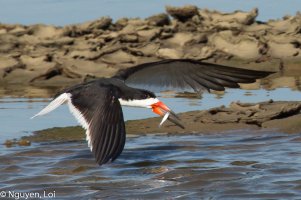I am looking to move up from my current EF 100-400mm f/4.5-5.6 L IS USM lens to one of Canon's supertele primes. The 100-400 is a good lens, particularly if your just starting out with wildlife and birds, but it definitely has its limitations. I primarily shoot birds, with some wildlife and general nature stuff mixed in. I pretty much always shoot at 400mm for birds and wildlife. I used to shoot at f/5.6 to blur out backgrounds, however this lens is fairly soft at that aperture. Fine feather detail, even of perching/wading/still birds, does not show up well. I've more recently begun to shoot at f/7.1, however I frequently run into lighting issues, particularly during the more early morning/late afternoon times (when I am usually out shooting), and end up needing ISO 3200 more often than I would prefer (the 7D does well up through 2500 (excluding 2000), but above that it really goes down hill.)
I am looking to get a prime lens that will be versatile enough for the kind of work I do, while being as sharp as possible wide open. From what I've read, the Canon EF 300mm f/2.8 L II IS USM is one of, if not the, sharpest lens Canon makes. I currently own a 1.4x TC, and would probably grab a 2x TC as well if I picked up an f/2.8 supertele prime. I'm curious what the hand-holdability of this lens is, though. It sounds like it rolls in at about 5.2 pounds? Thats about 2.2 pounds heavier than the 100-400, not counting the weight of a TC. With a 2x TC, that adds nearly another pound, bringing total weight to about 6 pounds or so. Using the 100-400mm+7D all day, my wrist tends to get a bit sore...and I'm wondering if anyone has experience using this lens hand-held with a TC on a regular basis. I'd also be curious to know how the Canon EF 400mm f/2.8 L II IS USM lens is in the same context.
I am looking to get a prime lens that will be versatile enough for the kind of work I do, while being as sharp as possible wide open. From what I've read, the Canon EF 300mm f/2.8 L II IS USM is one of, if not the, sharpest lens Canon makes. I currently own a 1.4x TC, and would probably grab a 2x TC as well if I picked up an f/2.8 supertele prime. I'm curious what the hand-holdability of this lens is, though. It sounds like it rolls in at about 5.2 pounds? Thats about 2.2 pounds heavier than the 100-400, not counting the weight of a TC. With a 2x TC, that adds nearly another pound, bringing total weight to about 6 pounds or so. Using the 100-400mm+7D all day, my wrist tends to get a bit sore...and I'm wondering if anyone has experience using this lens hand-held with a TC on a regular basis. I'd also be curious to know how the Canon EF 400mm f/2.8 L II IS USM lens is in the same context.


